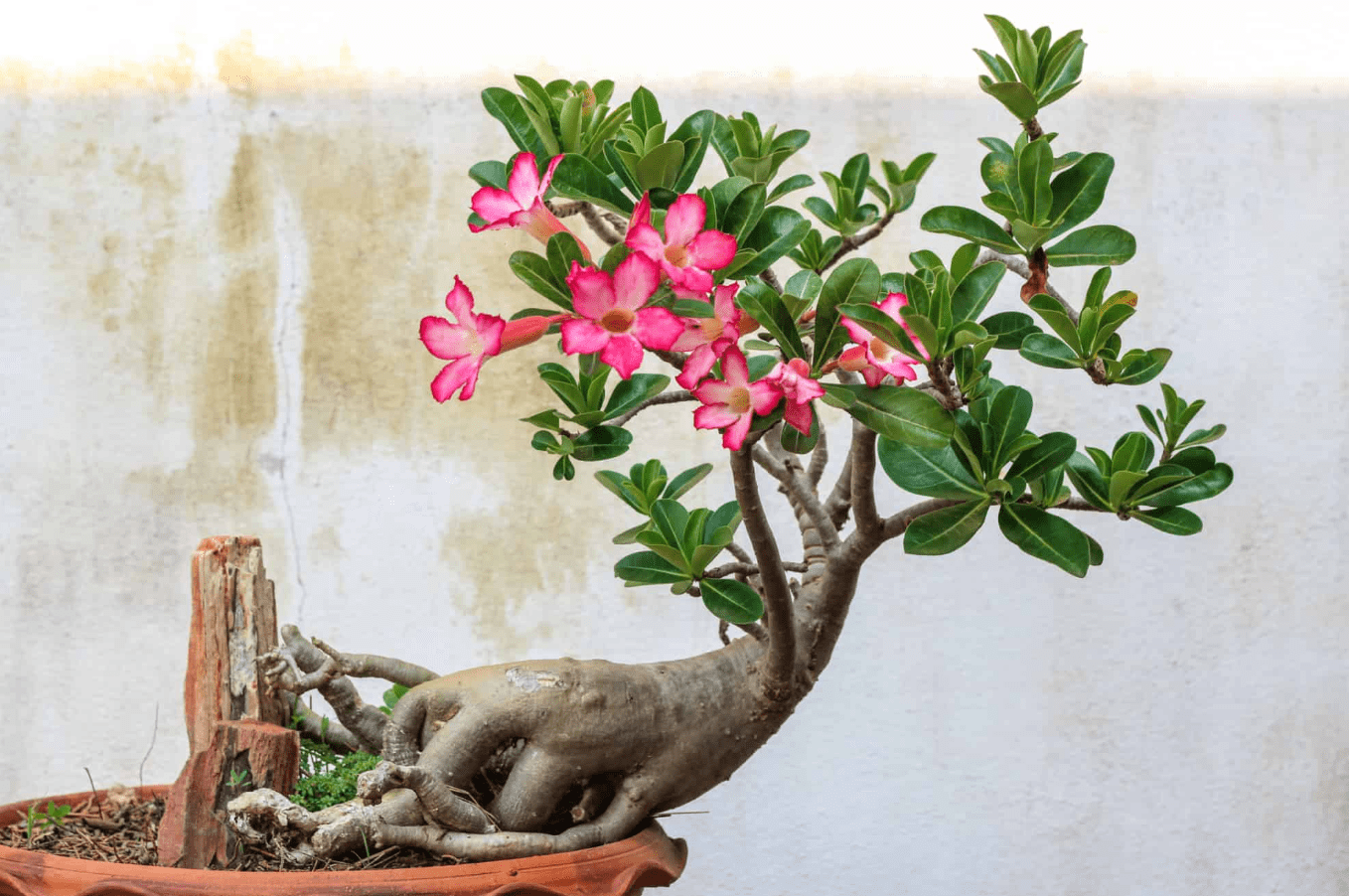Although creating a desert rose tree bonsai requires patience and care, this plant is suitable for both beginners and experts. The desert rose bonsai tree originates from Africa. And it needs lots of sunlight and warm temperatures to grow. But what do you need to know about general care for this plant? And how to shape and prune it to suit its growth? Here’s everything you need to know about desert rose bonsai trees. Whether you are new to keeping bonsai trees or want to add to your collection! The desert rose bonsai tree is worth a try. Both in flowers and roots Now let’s delve deeper.
Table of Contents
Common Types of Desert Rose Bonsai Trees
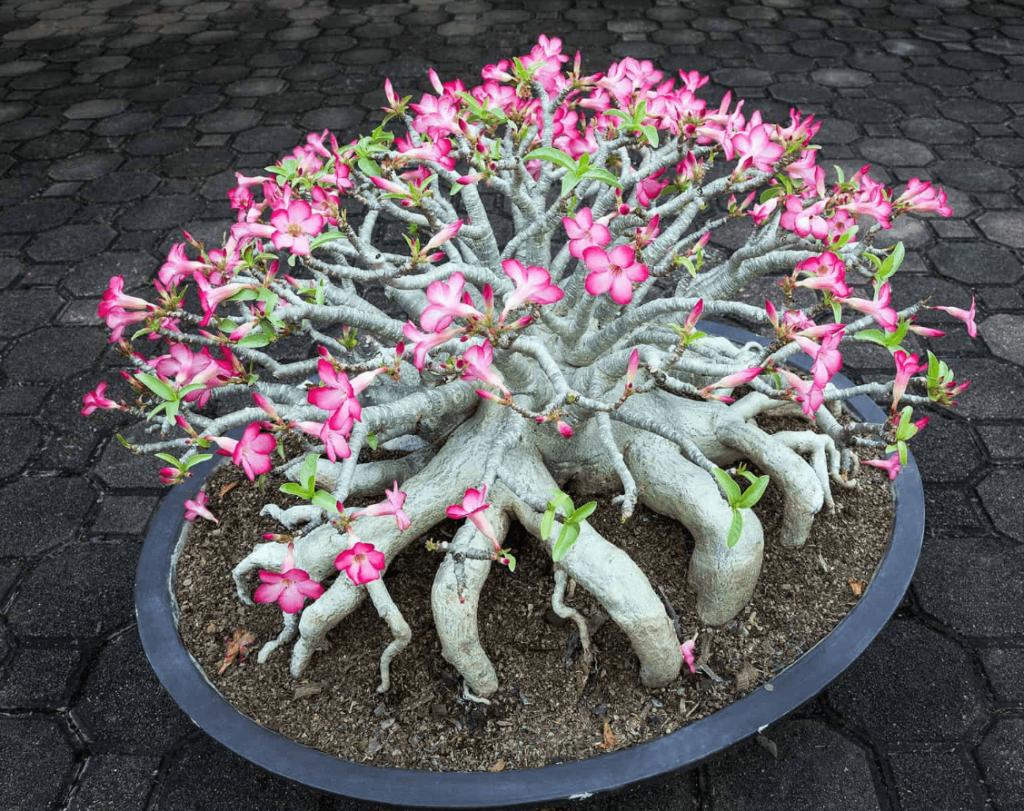
The Adenium genus includes all desert rose bonsai trees, with Adenium obesum being the most widespread species. However, it is important to note that there are many types of desert rose bonsai trees. The appearance and flower production of many of these subspecies differ. But the care required for them is no different. Let’s examine it more closely.
Oleifolium
The oleifolium subspecies of the desert rose tree grows to a miniature size and resembles a baobab tree. This plant specimen is an excellent choice for a small garden or bonsai container. Because when it is mature it has an average height of less than 20 inches and has pink, red or white flowers.
Swazicum
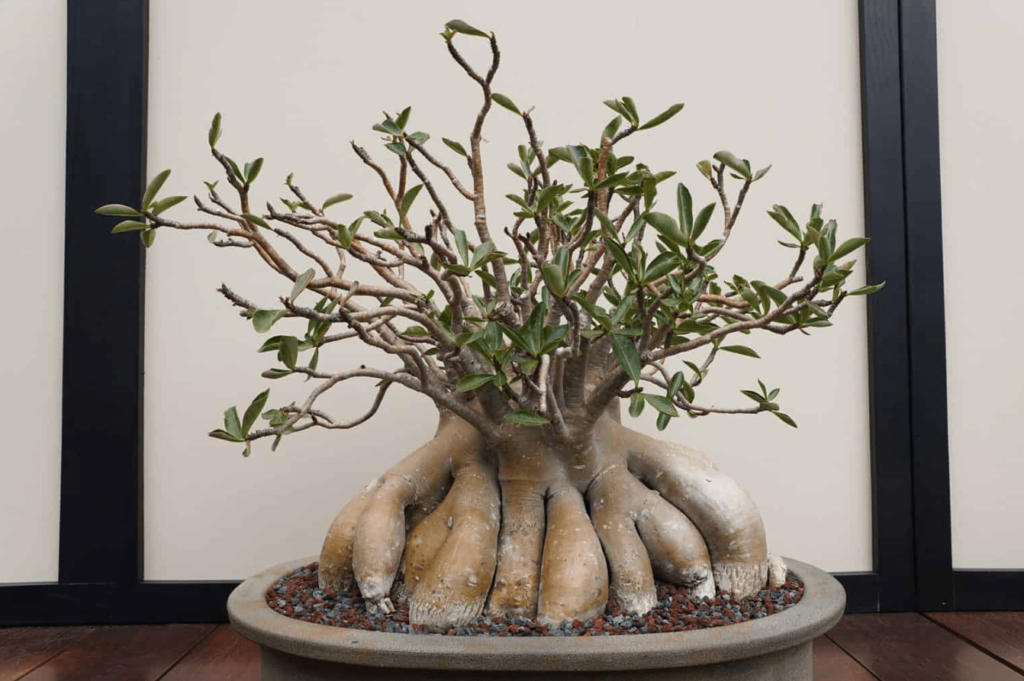
The Swazicum subspecies, also known as Impala Lily, grows to a small height. Swazicum is taller than the oleifolium subspecies, with an average height of less than 30 inches. It is widely used to make bonsai trees. Produces beautiful flowers amidst dark green foliage. You can often see pink flowers blooming.
Arabicum
Adenium arabicum is another species that is highly sought after for making bonsai trees. It is not yet known whether this is a subspecies of Adenium obesum. However, compared to other Adenium obesum plants, the leaves on this shrub are quite large. This doesn’t seem like a good place to plant a bonsai tree. But this desert rose is one of the most widely used!
Somalense
The popularity of Adenium obesum subsp. Somalense is caused by the leaves. This desert rose subspecies grows on narrow, variegated leaves. However in their natural habitat They usually reach a height of 10 feet. Therefore, they are ideal for growing bonsai trees. Especially when combined with delicate and clustered flowers.
Caring for Your Desert Rose Bonsai Tree
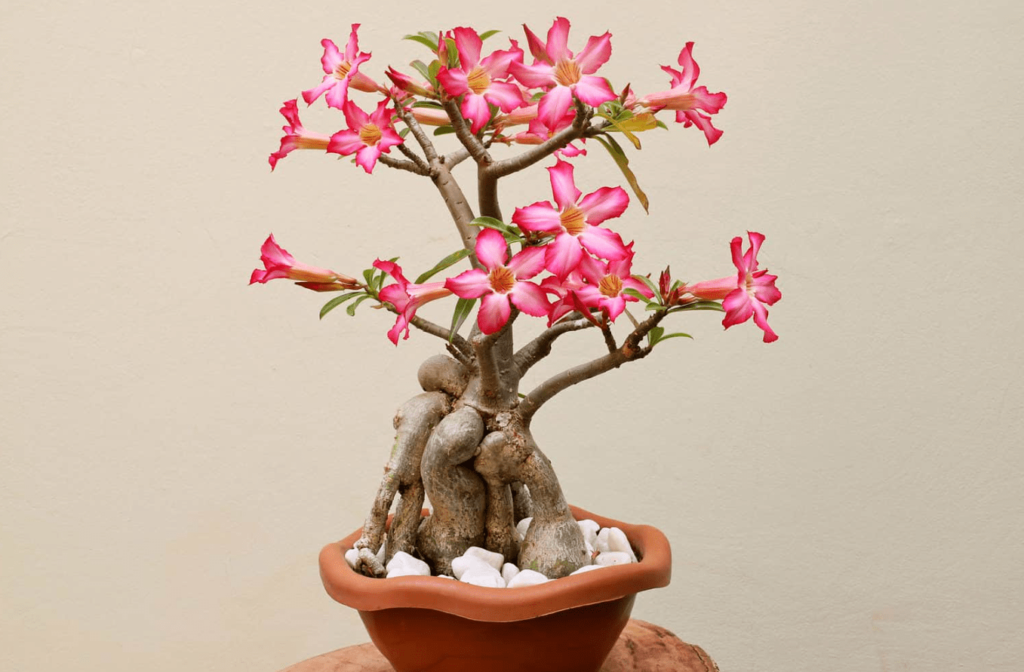
The desert rose bonsai tree is one of the easiest to care for. Although every bonsai tree requires regular care, when it receives sufficient sunlight, the desert rose bonsai tree can grow indoors. Unlike some finicky trees or plants, keeping your outdoor desert rose plant at the right temperature also makes caring for it easier! Let’s look at every detail of the care needs of this bonsai tree.
Sunlight
Whether you grow desert roses outdoors or indoors, most people like bright light. This is especially true for desert rose bonsai plants grown indoors. However, your desert rose bonsai plant may benefit from shade during the warmest times if grown outdoors. This bonsai tree likes full light. So all you need is a simple cover or shadow point!
Soil Type
Although all types of bonsai trees require well-draining soil, desert rose bonsai trees generally require higher drainage properties. This is because the stems and stems of this plant are succulent. Because it has a natural habitat, therefore, water is stored naturally. This is good news for those who forget to water their plants. Your desert rose bonsa tree should be planted in a soil mixture that contains pumice, lava rock, or other materials. It helps drain the water properly.
Water
Compared to other plants or trees your desert rose bonsai tree requires less water. The desert rose bonsa tree, as the name suggests, originates from very dry and arid areas. All desert rose plants can die from too much water. This is because this shrub is very good at storing water for use when it is needed most. You can water your desert rose bonsa plant gradually as the soil dries out. Although this depends on the weather conditions and temperature where your plants grow. But it doesn’t have to happen more than once a week.
Placement
You can leave the desert rose bonsai tree outside all year round. This depends on your local climate, but keep in mind that most species and subspecies of desert rose may have difficulty tolerating temperatures below 45 degrees Fahrenheit for long periods of time. Provided the weather is suitable you can move desert roses indoors for the winter or place them in a greenhouse. Make sure your desert rose bonsai plant is in a bright, sunny location. If you decide to care for it in your home for the rest of its life, Never underestimate the importance of light and warmth for your plant. If you don’t have these things, you will suffer. The most satisfying part of having a desert rose bonsai tree is when it blooms. This cannot be done without adequate lighting!
Pruning Your Desert Rose Bonsai Tree
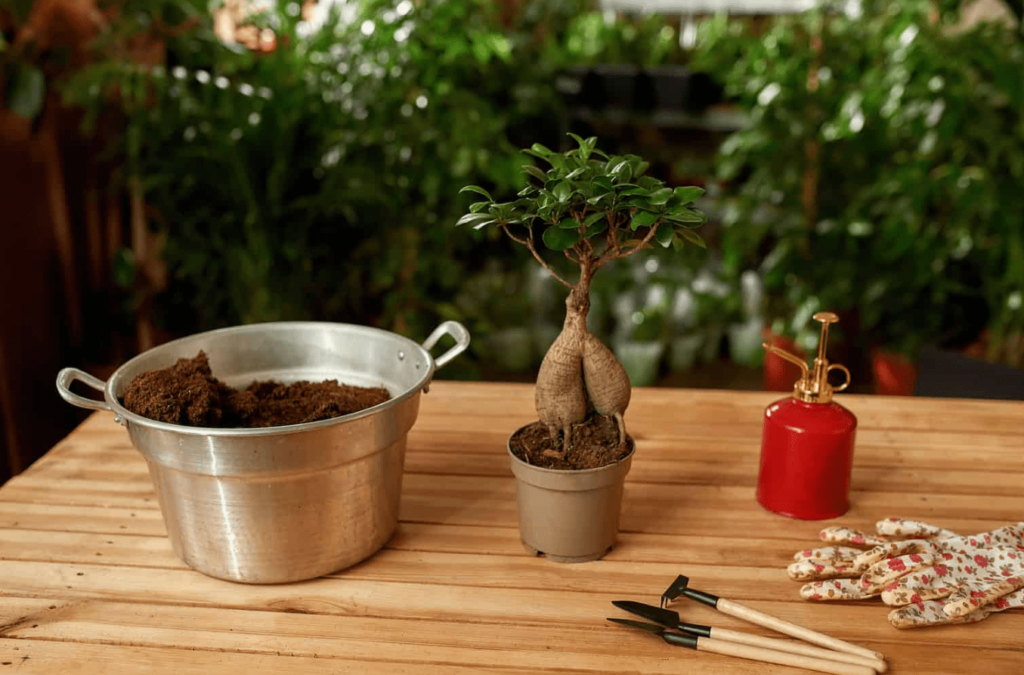
Desert rose bonsai trees are a great choice for beginners. This is partly due to the ability to prune at any time of the year or season. But what if you want more blooms on your desert rose bonsai tree? Spring is considered the best time for pruning. Pruning and removing dead or thin plant parts can help. It is important to remember that the sap or secretions that result from pruning desert roses are highly toxic. When pruning desert rose bonsa trees Many experts recommend using gloves. You should always keep this milk out of reach of small children and animals. Your desert rose bonsai tree will appreciate careful pruning!
Recommended Desert Rose Bonsai Tree Styles
You should not have much difficulty creating and caring for your desert rose bonsai tree. However, this plant grows well in most forms of bonsai because of its wide, round stem. Therefore, it is best planted as one tree. Instead, plant them in the wild or in a container with other specimens. Remember that desert roses have relatively fresh stems and limbs. Therefore, you have to arrange it carefully. Take the time to wire these plants. Because if you are not careful it can easily damage it!
Propagating Your Desert Rose Bonsai Tree
You can create a desert rose plant or tree by taking a cutting from an existing specimen if you know someone. The best seasons to harvest cuttings are spring and summer. This is the time of most rapid growth. But keep in mind that if you grow desert rose bonsai from cuttings, rather than seeds, the bonsai tree may not have the characteristic round trunk. Propagating desert roses Although growing a bonsai tree from seed is a very simple process, it will take longer than growing a tree from a cutting. But this is the best way to ensure your desert rose has a distinctive stem and branch structure. It will appear as you wish. Growing bonsai trees from seeds can be difficult because it requires patience!
Common Problems with Desert Rose Bonsai Trees
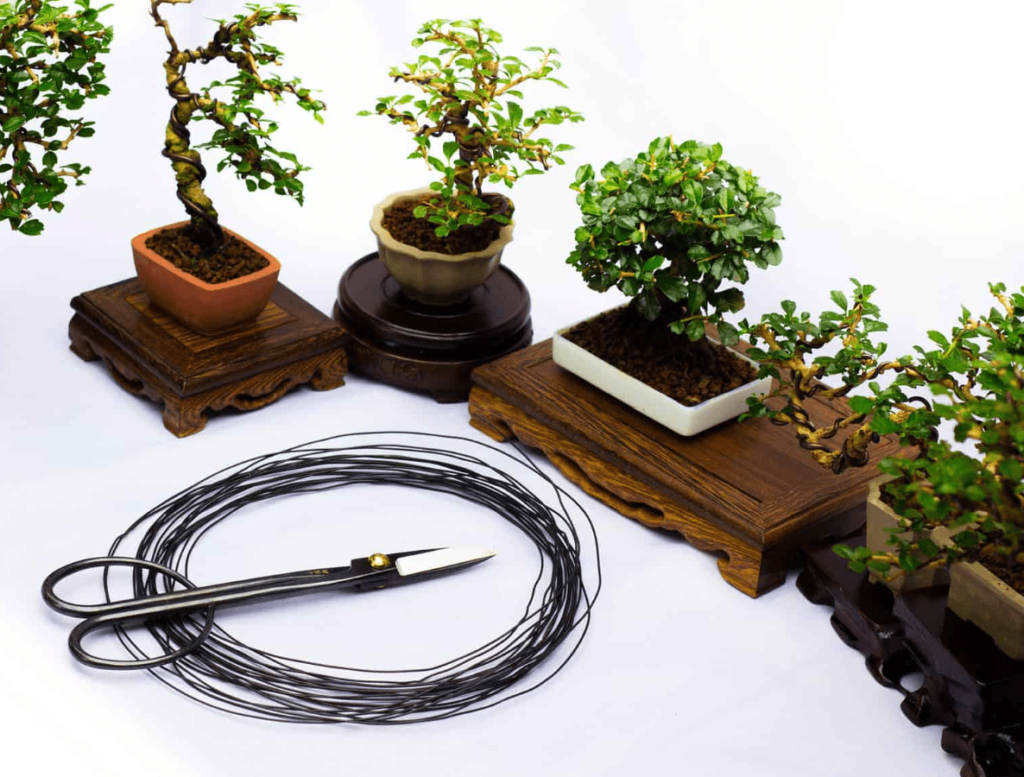
There are several common problems that can occur with your desert rose bonsai tree depending on where you keep it. After watering in the first period Pay attention to the general health and well-being of the plant. This is because root rot and overwatering are major problems for most desert rose owners. When wiring or carving a desert rose bonsai tree you run the risk of damaging it. Don’t wrap the desert rose too tightly. And tie the wire only if you feel comfortable doing so. They get hurt easily. Especially after calling for too long!
